Cabernet Sauvignon
Cabernet Sauvignon (French: [kabɛʁnɛ soviˈɲɔ̃]) is one of the world's most widely recognized red wine grape varieties. It is grown in nearly every major wine producing country among a diverse spectrum of climates from Canada's Okanagan Valley to Lebanon's Beqaa Valley. Cabernet Sauvignon became internationally recognized through its prominence in Bordeaux wines where it is often blended with Merlot and Cabernet Franc. From France and Spain, the grape spread across Europe and to the New World where it found new homes in places like California's Santa Cruz Mountains, Paso Robles, Napa Valley, New Zealand's Hawkes Bay, South Africa's Stellenbosch region, Australia's Margaret River and Coonawarra regions, and Chile's Maipo Valley and Colchagua. For most of the 20th century, it was the world's most widely planted premium red wine grape until it was surpassed by Merlot in the 1990s.[1] However, by 2015, Cabernet Sauvignon had once again become the most widely planted wine grape, with a total of 341,000 hectares (3,410 km2) under vine worldwide.[2]
| Cabernet Sauvignon | |
|---|---|
| Grape (Vitis) | |
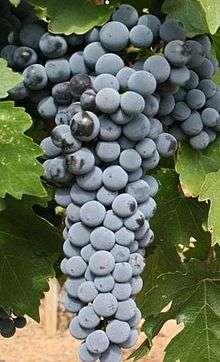 Cabernet Sauvignon grapes | |
| Color of berry skin | Black |
| Also called | Bouchet, Bouche, Petit-Bouchet, Petit-Cabernet, Petit-Vidure, Vidure, Sauvignon Rouge |
| Notable regions | Bordeaux, Tuscany, Santa Cruz Mountains, Napa Valley, Sonoma County, Australia, South Africa, Friuli |
| Notable wines | Classified Bordeaux estates, Californian cult wines |
| Ideal soil | Gravel |
| Hazards | Underripeness, powdery mildew, eutypella scoparia, excoriose |
| VIVC number | 1929 |
| Wine characteristics | |
| General | Dense, dark, tannic |
| Cool climate | Vegetal, bell pepper, asparagus |
| Medium climate | Mint, black pepper, eucalyptus |
| Hot climate | Jam |
Despite its prominence in the industry, the grape is a relatively new variety, the product of a chance crossing between Cabernet Franc and Sauvignon blanc during the 17th century in southwestern France. Its popularity is often attributed to its ease of cultivation—the grapes have thick skins and the vines are hardy and naturally low yielding, budding late to avoid frost and resistant to viticultural hazards such as rot and insects—and to its consistent presentation of structure and flavours which express the typical character ("typicity") of the variety. Familiarity and ease of pronunciation have helped to sell Cabernet Sauvignon wines to consumers, even when from unfamiliar wine regions. Its widespread popularity has also contributed to criticism of the grape as a "colonizer" that takes over wine regions at the expense of native grape varieties.[3]
The classic profile of Cabernet Sauvignon tends to be full-bodied wines with high tannins and noticeable acidity that contributes to the wine's aging potential. In cooler climates, Cabernet Sauvignon tends to produce wines with blackcurrant notes that can be accompanied by green bell pepper notes, mint and cedar which will all become more pronounced as the wine ages. In more moderate climates the blackcurrant notes are often seen with black cherry and black olive notes while in very hot climates the currant flavors can veer towards the over-ripe and "jammy" side. In parts of Australia, particularly the Coonawarra wine region of South Australia, Cabernet Sauvignon wines tend to have a characteristic eucalyptus or menthol notes.[4]
History and origins
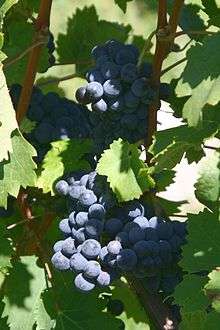
For many years, the origin of Cabernet Sauvignon was not clearly understood and many myths and conjectures surrounded it. The word "Sauvignon" is believed to be derived from the French sauvage meaning "wild" and to refer to the grape being a wild Vitis vinifera vine native to France. Until recently the grape was rumored to have ancient origins, perhaps even being the Biturica grape used to make ancient Roman wine and referenced by Pliny the Elder. This belief was widely held in the 18th century, when the grape was also known as Petite Vidure or Bidure, apparently a corruption of Biturica. There was also belief that Vidure was a reference to the hard wood (French vigne dure) of the vine, with a possible relationship to Carménère which was once known as Grand Vidure.[3] Another theory was that the grapevine originated in the Rioja region of Spain.[5]
While the period when the name Cabernet Sauvignon became more prevalent over Petite Vidure is not certain, records indicate that the grape was a popular Bordeaux planting in the 18th century Médoc region. The first estates known to have actively grown the variety (and the likely source of Cabernet vines for other estates) were Château Mouton and Château d'Armailhac in Pauillac.[3]
The grape's true origins were discovered in 1996 with the use of DNA typing at the UC Davis Department of Viticulture and Enology, by a team led by Dr. Carole Meredith. The DNA evidence determined that Cabernet Sauvignon was the offspring of Cabernet franc and Sauvignon blanc and was most likely a chance crossing that occurred in the 17th century. Prior to this discovery, this origin had been suspected from the similarity of the grapes' names and the fact that Cabernet Sauvignon shares similar aromas with both grapes—such as the blackcurrant and pencil box aromas of Cabernet franc and the grassiness of Sauvignon blanc.[3] In 2016 scientists at the UC Davis announced they had sequenced a draft of the whole genome of the Cabernet Sauvignon grape, the first genome of a commercial wine-producing grape to be sequenced.[6]
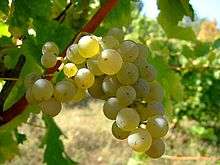
Offspring and White Cabernet
While not as prolific in mutating as Pinot noir, nor as widely used in production of offspring, Cabernet Sauvignon has been linked to other grape varieties. In 1961, a cross of Cabernet Sauvignon and Grenache produced the French wine grape Marselan.[7] Cygne blanc is a white-berried seedling of Cabernet Sauvignon that was discovered in 1989 growing in a garden in Swan Valley, Western Australia. Cabernet blanc is a crossing of Cabernet Sauvignon and an unknown hybrid grape variety that was discovered in Switzerland in the late 20th century.[8]
In 1977 a vine producing 'bronze' grapes was found in the vineyards of Cleggett Wines in Australia. They propagated this mutant, registered it under the name of Malian, and sold pale red wines under that name. In 1991 one of the Bronze Cabernet vines started producing white grapes. Cleggett registered this "White Cabernet" under the name of Shalistin.[9] Compared to its Cabernet parent, Malian appears to lack anthocyanins in the subepidermal cells but retains them in the epidermis, whereas Shalistin has no anthocyanins in either layer. The team that went on to discover the VvMYBA1 and VvMYBA2 genes that control grape color have suggested that a gene involved in anthocyanin production has been deleted in the subepidermis of Malian, and then subepidermal cells invaded the epidermis to produce Shalistin.[10]
During a series of trials between 1924 and 1930, the pollen of Cabernet Sauvignon was used to fertilize Glera vines (the white wine grape used to make the sparkling wine Prosecco) to create the red Italian wine grape Incrocio Manzoni 2.15.[11]
In 1972, the Australian agency CSIRO crossed Cabernet Sauvignon grapes with the Spanish Sumoll variety to create three new varieties: Cienna, Tyrian and Rubienne.[12]
In 1983, Cabernet Sauvignon was crossed with the white German wine grape Bronner to create the white wine grape Souvignier gris.[13]
Viticulture
While Cabernet Sauvignon can grow in a variety of climates, its suitability as a varietal wine or as a blend component is strongly influenced by the warmth of the climate. The vine is one of the last major grape varieties to bud and ripen (typically 1–2 weeks after Merlot and Cabernet franc[1]) and the climate of the growing season affects how early the grapes will be harvested. Many wine regions in California give the vine an abundance of sunshine with few problems in ripening fully, which increases the likelihood of producing varietal Cabernet wines. In regions like Bordeaux, under the threat of inclement harvest season weather, Cabernet Sauvignon is often harvested a little earlier than ideal and is then blended with other grapes to fill in the gaps. In some regions, climate will be more important than soil. In regions that are too cool, there is a potential for more herbaceous and green bell pepper flavours from less than ideally ripened grapes. In regions where the grape is exposed to excess warmth and over-ripening, there is a propensity for the wine to develop flavours of cooked or stewed blackcurrants.[3]
The Cabernet grape variety has thrived in a variety of vineyard soil types, making the consideration of soil less of concern particularly for New World winemakers. In Bordeaux, the soil aspect of terroir was historically an important consideration in determining which of the major Bordeaux grape varieties were planted. While Merlot seemed to thrive in clay- and limestone-based soils (such as those of the Right Bank regions of the Gironde estuary), Cabernet Sauvignon seemed to perform better in the gravel-based soil of the Médoc region on the Left Bank. The gravel soils offered the benefit of being well drained while absorbing and radiating heat to the vines, aiding ripening. Clay- and limestone-based soils are often cooler, allowing less heat to reach the vines, delaying ripening. In regions where the climate is warmer, there is more emphasis on soil that is less fertile, which promotes less vigor in the vine which can keep yields low.[3] In the Napa Valley wine regions of Oakville and Rutherford, the soil is more alluvial and dusty. Rutherford Cabernet Sauvignon has been often quoted as giving a sense of terroir with a taste of "Rutherford dust".[14] In the South Australian wine region of Coonawarra, Cabernet Sauvignon has produced vastly different results from grape vines planted in the region's terra rosa soil – so much so that the red soil is considered the "boundary" of the wine region, with some controversy from wine growers with Cabernet Sauvignon planted on red soil.[15]
In addition to ripeness levels, the harvest yields can also have a strong influence in the resulting quality and flavors of Cabernet Sauvignon wine. The vine itself is prone to vigorous yields, particularly when planted on the vigorous SO4 rootstock. Excessive yields can result in less concentrated and flavorful wine with flavors more on the green or herbaceous side. In the 1970s, a particular clone of Cabernet Sauvignon that was engineered to be virus free was noted for its very high yields-causing many quality conscious producers to replant their vineyards in the late 20th century with different clonal varieties. To reduce yields, producers can plant the vines on less vigorous rootstock and also practice green harvesting with aggressive pruning of grape clusters soon after veraison.[3]
In general, Cabernet Sauvignon has good resistance to most grape diseases, powdery mildew being the most noted exception. It is, however, susceptible to the vine diseases Eutypella scoparia and excoriose.[1]
The "green bell pepper" flavor
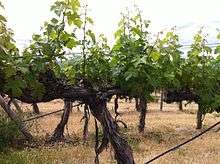
There are a couple of noted Cabernet Sauvignon flavors that are intimately tied to viticultural and climate influences. The most widely recognized is the herbaceous or green bell pepper flavor caused by pyrazines, which are more prevalent in underripened grapes. Pyrazine compounds are present in all Cabernet Sauvignon grapes and are gradually destroyed by sunlight as the grape continues to ripen. To the human palate this compound is detectable in wines with pyrazine levels as low as 2 nanograms (ng) per liter. At the time of veraison, when the grapes first start to fully ripen, there is the equivalent pyrazine level of 30 ng/l. In cooler climates, it is difficult to get Cabernet Sauvignon grapes to ripen fully to the point where pyrazine is not detected. The green bell pepper flavor is not considered a wine fault but it may not be desirable to all consumers' tastes. The California wine region of Monterey was noted in the late 20th century for its very vegetal Cabernet Sauvignon with pronounced green pepper flavor, earning the nickname of "Monterey veggies". In addition to its cool climate, Monterey is also prone to being very windy, which can have the effect of shutting down the grape vines and further inhibiting ripeness.[3]
Two other well known Cabernet Sauvignon flavors are mint and eucalyptus. Mint flavors are often associated with wine regions that are warm enough to have low pyrazine levels but are still generally cool, such as Australia's Coonawarra region and some areas of Washington State. There is some belief that soil could also be a contributor to the minty notes, since the flavor also appears in some wines from the Pauillac region but not from the similar climate of Margaux. Resinous Eucalyptus flavors tend to appear in regions that are habitats for the eucalyptus tree, such as California's Napa and Sonoma valleys and parts of Australia, but there has been no evidence to conclusively prove a direct link between proximity of eucalyptus trees and the presence of that flavor in the wine.[3]
Winemaking
In many aspects, Cabernet Sauvignon can reflect the desires and personality of the winemaker while still presenting familiar flavors that express the typical character of the variety. The most pronounced effects are from the use of oak during production. Typically the first winemaking decision is whether or not to produce a varietal or blended wine. The "Bordeaux blend" of Cabernet Sauvignon, Merlot and Cabernet franc, with potentially some Malbec, Petit Verdot or Carménère, is the classic example of blended Cabernet Sauvignon, emulated in the United States with wines produced under the "Meritage" designation. But Cabernet Sauvignon can be blended with a variety of grapes such as Shiraz, Tempranillo and Sangiovese.[3] The decision to blend is then followed by the decision of when to do the blending—before, during or after fermentation. Due to the different fermentation styles of the grapes, many producers will ferment and age each grape variety separately and blend the wine shortly before bottling.[16]
The Cabernet Sauvignon grape itself is very small, with a thick skin, creating a high 1:12 ratio of seed (pip) to fruit (pulp).[17] From these elements the high proportions of phenols and tannins can have a stark influence on the structure and flavor of the wine—especially if the must is subjected to long periods of maceration (skin contact) before fermentation. In Bordeaux, the maceration period was traditionally three weeks, which gave the winemaking staff enough time to close down the estate after harvest to take a hunting holiday. The results of these long maceration periods are very tannic and flavorful wines that require years of aging. Wine producers that wish to make a wine more approachable within a couple of years will drastically reduce the maceration time to as little as a few days. Following maceration, the Cabernet must can be fermented at high temperatures up to 30 °C (86 °F). The temperature of fermentation will play a role in the result, with deeper colors and more flavor components being extracted at higher temperatures while more fruit flavors are maintained at lower temperature. In Australia there has been experimentation with carbonic maceration to make softer, fruity Cabernet Sauvignon wines.[3]
The tannic nature of Cabernet Sauvignon is an important winemaking consideration. As the must is exposed to prolonged periods of maceration, more tannins are extracted from the skin and will be present in the resulting wine. If winemakers choose not to shorten the period of maceration, in favor of maximizing color and flavor concentrations, there are some methods that they can use to soften tannin levels. A common method is oak aging, which exposes the wine to gradual levels of oxidation that can mellow the harsh grape tannins as well as introduce softer "wood tannins". The choice of fining agents can also reduce tannins with gelatin and egg whites being positively-charged proteins that are naturally attracted to the negatively charged tannin molecules. These fining agents will bond with some of the tannins and be removed from the wine during filtration. One additional method is micro-oxygenation which mimics some of the gradual aeration that occurs with barrel aging, with the limited exposure to oxygen aiding in the polymerization of the tannins into larger molecules, which are perceived on the palate as being softer.[5]
Affinity for oak
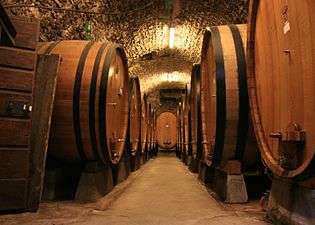
One of the most noted traits of Cabernet Sauvignon is its affinity for oak, either during fermentation or in barrel aging. In addition to having a softening effect on the grape's naturally high tannins, the unique wood flavors of vanilla and spice complement the natural grape flavors of blackcurrant and tobacco. The particular success of Cabernet-based Bordeaux blends in the 225 liter (59 gallon) barrique were a significant influence in making that barrel size one of the most popular worldwide. In winemaking, the decision for the degree of oak influence (as well as which type of oak) will have a strong impact on the resulting wine. American oak, particularly from new barrels, imparts stronger oak flavors that are less subtle than those imparted by French oak. Even within the American oak family, the location of the oak source also plays a role with oak from the state of Oregon having more pronounced influence on Cabernet Sauvignon than oak from Missouri, Pennsylvania and Virginia. Winemakers often use a variety of oak barrels from different locations and of different ages and blend the wine as if they are blending different grape varieties.[3]
Winemakers can also control the influence of oak by using alternatives to the standard barrique barrels. Larger barrels have a smaller wood-to-wine ratio and therefore less pronounced oak flavors. Winemakers in Italy and Portugal sometimes use barrels made from other wood types such as chestnut and redwood. Another method that winemakers consider is tea bagging with oak chips or adding oak planks to the wines while fermenting or aging it in stainless steel tanks. While these methods are less costly than oak barrels, they create more pronounced oak flavors, which tend not to mellow or integrate with the rest of the wine's components; nor do they provide the gradual oxidation benefit of barrel aging.[5]
Wine regions
Bordeaux
The Bordeaux wine region is intimately connected with Cabernet Sauvignon, even though wine is rarely made without the blended component of other grape varieties. It is the likely "birthplace" of the vine, and producers across the globe have invested heavily in trying to reproduce the structure and complexity of Bordeaux wines. While the "Bordeaux blend" of Cabernet Sauvignon, Cabernet franc and Merlot created the earliest examples of acclaimed Cabernet Sauvignon wine, Cabernet Sauvignon was first blended in Bordeaux with Syrah (from the Northern Rhone), a pairing that is widely seen in Australia and some vin de pays wines from the Languedoc.
The decision to first start blending Cabernet Sauvignon was partly derived from financial necessity. The sometime temperamental and unpredictable climate of Bordeaux during the "Little Ice Age" did not guarantee a successful harvest every year; producers had to insure themselves against the risk of losing an entire vintage by planting a variety of grapes. Over time it was discovered that the unique characteristics of each grape variety can complement each other and enhance the overall quality of wine. As a base, or backbone of the wine, Cabernet Sauvignon added structure, acidity, tannins and aging potential. By itself, particularly when harvested at less than ideal ripeness, it can lack a sense of fruit or "fleshiness" on the palate which can be compensated by adding the rounder flavors of Merlot. Cabernet franc can add additional aromas to the bouquet as well as more fruitiness. In the lighter soils of the Margaux region, Cabernet-based wines can lack color, which can be achieved by blending in Petit Verdot. Malbec, used today mostly in Fronsac, can add additional fruit and floral aromas.[3]
DNA evidence has shown Cabernet Sauvignon is the result of the crossing of two other Bordeaux grape varieties— Cabernet franc and Sauvignon blanc— which has led grapevine historians, or ampelographers, to believe that the grape originated in Bordeaux. Early records indicate that the grape was a popular planting in the Médoc region during the 18th century. The loose berry clusters and thick skins of the grape provided a good resistance to rot in the sometimes wet maritime climate of Bordeaux. The grape continued to grow in popularity until the Powdery mildew epidemic of 1852 exposed Cabernet Sauvignon's sensitivity to that grape disease. With vineyards severely ravaged or lost, many Bordeaux wine growers turned to Merlot, increasing its plantings to where it soon became the most widely planted grape in Bordeaux. As the region's winemakers started to better understand the area's terroir and how the different grape varieties performed in different region, Cabernet Sauvignon increased in plantings all along the Left Bank region of the Gironde river in the Médoc as well as Graves region, where it became the dominant variety in the wine blends. In the Right bank regions of Saint-Émilion and Pomerol, Cabernet is a distant third in plantings behind Merlot & Cabernet franc.[3]
In the wine regions of the Left Bank, the Cabernet influence of the wine has shown unique characteristics in the different regions. In Saint-Estèphe and Pessac-Léognan, the grape develops more mineral flavors. Aromas of violets are a characteristic of Margaux. Pauillac is noted by a strong lead pencil scent and Saint-Julien by cedar and cigar boxes. The Cabernet wines of the Moulis are characterized by their soft tannins and rich fruit flavors while the southern Graves region is characterized by strong blackcurrant flavors, though in less intense wines over all.[3] The percentage of Cabernet Sauvignon used in the blend will depend on terroir and the winemakers styles as well as the vintage. The First Growth estates of Château Mouton Rothschild and Château Latour are noted for regularly producing wines with some of the highest percentage of Cabernet— often around 75%.[1]
A common factor affecting the flavors of Bordeaux wines is the harvest yields of Cabernet Sauvignon. Throughout Bordeaux there is a legal maximum permitted yield of 50 hectoliters (hl) per hectare (ha). With the aid of global warming and vigorous rootstocks, many Bordeaux vineyards can easily surpass 60 hl/ha, with some estates taking advantage of the legal loophole of plafond limite de classement ("ceiling limit classification") that permits higher yields during "exceptional" years. This has had an adverse effect on the quality of production from some producers who regularly use grapes harvested at excessive yields. In recent years there has been more of an emphasis on keeping yields low, particularly for an estate's Grand vin.[3]
Other French regions
The Bordeaux wine region accounts for more than 60% of the Cabernet Sauvignon grown in France. Outside of Bordeaux, Cabernet Sauvignon is found in varying quantities throughout Le Midi and in the Loire Valley. In general, Cabernet Sauvignon wines are lighter and less structured, drinkable much earlier than Bordeaux wine. In the southwest French appellation d'origine contrôlée (AOCs) of Bergerac and Buzet it is used to make rosé wine. In some regions it is used to add flavor and structure to Carignan while it is blended with Négrette in Gaillac and Fronton as well as Tannat in Madiran. In Provence, the grape had some presence in the region in the mid 19th century, when viticulturist Jules Guyot recommended it as a blending partner with Syrah. In recent years, several Midi wine estates, such as Mas de Daumas Gassac have received international acclaim for their Cabernet Sauvignon blended in Hérault, with Rhône grapes like Syrah. It is often made as a single varietal in the vin de pays of the Languedoc. The influence of Australian flying winemakers has been considerable in how Cabernet Sauvignon is treated by some Languedoc wine estates, with some producers making wines that can seem like they are from the New World. Overall, the grape has not exerted it dominance of the region, generally considered less ideally situated to the dry climate than Syrah. The Languedoc producers who give serious consideration to Cabernet Sauvignon, generally rely on irrigation to compensate for the climate.[1]
Italy
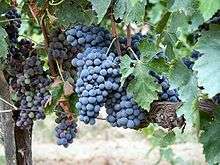
Cabernet Sauvignon has a long history in Italian wines, being first introduced to the Piedmont region in 1820. In the mid-1970s, the grape earned notoriety and controversy as a component in the so-called "Super Tuscan" wines of Tuscany. Today the grape is permitted in several Denominazioni di origine controllata (DOCs) and is used in many Indicazione Geografica Tipica (IGT) wines that are made outside DOC perimeters in certain regions. For most of its history the grape has been viewed with suspicion as a "foreign influence" that distracts from the native grape varieties. After decades of experimentation, the general view of Cabernet Sauvignon has improved as more winemakers find ways to complement their native grape varieties with Cabernet as a blending component.[3]
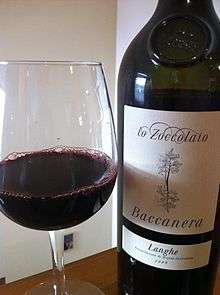
In Piedmont, the grape was sometimes used as an "illegal" blending partner with Nebbiolo for DOC classified Barolo with the intention of adding color and more fruit flavors. In the DOCs of Langhe and Monferrato, Cabernet is a permitted blending grape with Nebbiolo as well as Barbera. Wines that are composed of all three grape varieties are often subjected to considerable oak treatment to add a sense of sweet spiciness to compensate for the high tannins of Cabernet Sauvignon and Nebbiolo as well as the high acidity of Barbera. There are varietal styles of Cabernet Sauvignon produce in Piedmont with qualities varying depending on the location. In other regions of northern Italy, such as Lombardy, Emilia-Romagna and Friuli-Venezia Giulia, the grape is often blended with Merlot to produce Bordeaux style blends. In the Veneto region, Cabernet Sauvignon is sometimes blended with the main grapes of Valpolicella-Corvina, Molinara and Rondinella. In southern Italy, the grape is mostly used as a blending component with local varieties-such as Carignan in Sardinia, Nero d'Avola in Sicily, Aglianico in Campania and Gaglioppo in Calabria.[3]
Cabernet Sauvignon has had a controversial history in Tuscan wine, particularly for its role in the arrivals of "Super Tuscan" in the mid-1970s. The origin of Super Tuscans is rooted in the restrictive DOC practices of the Chianti zone prior to the 1990s. During this time Chianti could be composed of no more than 70% Sangiovese and had to include at least 10% of one of the local white wine grapes. Many Tuscan wine producers thought they could produce a better quality wine if they were not hindered by the DOC regulations, particularly if they had the freedom to use Cabernet Sauvignon in the blend and not required to use white grape varieties. The marchese Piero Antinori was one of the first to create a "Chianti-style" wine that ignored the DOC regulations, releasing a 1971 Sangiovese-Cabernet Sauvignon blend known as Tignanello in 1978. Other producers followed suit and soon the prices for these Super Tuscans were consistently beating the prices of some of the most well known Chianti.[18] Other Tuscan wine regions followed suit, blending Cabernet Sauvignon with Sangiovese and even making varietal versions of the grape. Gradually the DOC system caught on and began allowing more regions to use the grape in their DOC designated wines. Cabernet Sauvignon in Tuscany is characterized by ripe black cherry flavors that can give a perception of sweetness as well as strong notes of blackcurrant. The wines typically reach an alcohol level around 14% but can still maintain notable levels of acidity. When blended with Sangiovese in significant quantities, Cabernet Sauvignon can dominate the blend with most Tuscan producers aiming to find a particular balance that suits their desired style.[3]
Other Old World producers
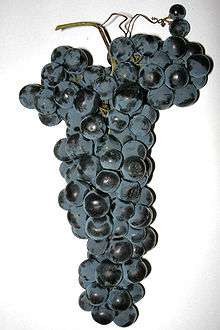
The introduction of Cabernet Sauvignon to Spain occurred in the Rioja region when the Marqués de Riscal planted cuttings from Bordeaux in the nineteenth century. It was not until the 1960s, however, before cultivation took off. By 2015, it was the sixth most widely planted red wine grape in Spain.[19] Today it is permitted in about half of the Spanish DOPs (Denominación de Origen Protegida).[20] The grape is most prominent in the Catalan wine region of Penedès, where its use was revived by the estates of Bodegas Torres and Jean León. There the grape is often blended with Tempranillo. It is also primarily a blending grape in the Ribera del Duero, but producers in Navarra have found some international acclaim for their varietal wines.[5]
In the United Kingdom, English wine producers have experimented with growing the variety in plastic tunnels which can create a greenhouse effect and protect the grapes from the less than ideal climate of the wine region. While the grape is permitted to be planted in some German wine regions (such as the Mosel), the vineyard sites best suited for ripening Cabernet are generally already occupied with Riesling; many producers are ill-inclined to uproot the popular German variety in favor of Cabernet Sauvignon. In the 1980s, inexpensive Bulgarian Cabernet Sauvignon was highly touted for its value and helped to establish that country's wine industry and garner it more international presence in the wine market. The grape is performing a similar function for many countries in Central Europe, including Czech Republic, Hungary, Slovenia, and Eastern Europe, including Moldova, Romania, Georgia, Turkey, Bulgaria and Ukraine. It can be in the eastern Mediterranean wine regions of Cyprus, Greece, Israel and Lebanon.[3]
California

In California, Cabernet Sauvignon has developed its characteristic style and reputation, recognizable in the world's market. Production and plantings of the grape in California are similar in quantity to those of Bordeaux.[1] The 1976 Judgment of Paris wine tasting event helped to catapult Californian Cabernet Sauvignons onto the international stage when Stag's Leap Wine Cellars' 1973 Stags Leap District Cabernet Sauvignon beat out classified Bordeaux estates like Château Mouton Rothschild, Château Montrose, Château Haut-Brion and Château Léoville-Las Cases in a blind tasting conducted by French wine experts.[5] In the 1980s, a new epidemic of phylloxera hit California, devastating many vineyards, which needed replanting. There was some speculation that ravaged Cabernet vineyards would be replanted with other varietals (such as those emerging from the Rhone Rangers movement) but in fact California plantings of Cabernet Sauvignon doubled between 1988 and 1998; many wine regions— such as Napa Valley north of Yountville and Sonoma's Alexander Valley— were almost completely dominated by the grape variety. It also started to gain a foothold in Dry Creek Valley, Sonoma Mountain and Mendocino County.[3] Cabernet from Sonoma County has shown a tendency to feature anise and black olive notes while Napa County Cabernets are characterized by their strong black fruit flavors.[5]
In California, the main stylistic difference in Cabernet Sauvignon is between hillside/mountain vineyards and those on flatter terrain like valley floors or some areas of the Central Valley. In Napa, the hillside vineyards of Diamond Mountain District, Howell Mountain, Mt. Veeder, Spring Mountain District have thinner, less fertile soils which produces smaller berries with more intense flavors, reminiscent of Bordeaux wines that require years of aging to mature. The yields are also much lower, typically in the range of 1–2 tons per acre in contrast to the 4–8 tons that can be produced in the more fertile valley floors.[3] Wines produced from mountainside vineyards tend to be characterized by deep inky colors and strong berry aromas. Throughout California there are many wine regions that have the potential to grow Cabernet Sauvignon to full ripeness and produce fruity, full-bodied wines with alcohol levels regularly above the Bordeaux average of 12–13%—often in excess of 14%.[5]
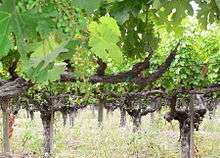
The use of oak in California Cabernet has a long history, with many producers favoring the use of new oak barrels heavily composed of American oak. After the early 1980s' unsuccessful trend to create more "food friendly" wines, with less ripeness and less oak influence, winemakers' focus shifted back to oak influence, but producers were more inclined to limit and lighten the use of oak barrels, with many turning to French oak or a combination of new and older oak barrels.[3]
Washington State
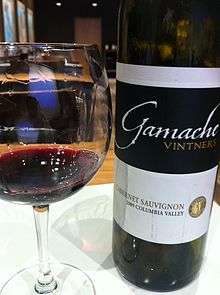
Cabernet Sauvignon is the most widely planted red grape variety in Washington state according to the Washington State Wine Commission. It is generally found in the warmer sites of the Columbia Valley. The vines are choice plantings for growers due to their hardy vine stalks and resistance to the cold winter frost that is commonplace in Eastern Washington. Washington Cabernet Sauvignon is characterized by its fruitiness and easy drinking styles that are not overly tannic.[3] Recent Washington American Viticultural Areas (AVAs) that have seen some success with their Cabernet Sauvignons include Red Mountain, Walla Walla Valley and parts of the Yakima Valley AVA near the Tri-Cities region.[5]
Elsewhere in the United States
In Oregon there are small quantities of Cabernet Sauvignon planted in the warmer southern regions of the Umpqua and Rogue Valleys.[3]
It has also started to develop a presence in the Arizona, New York, Ohio, Texas and Virginia wine industries-particularly in the Texas Hill Country and North Fork of Long Island AVAs. Throughout the United States, Cabernet Sauvignon is made in both varietal and blended styles. Under the American system, varietal Cabernet Sauvignon can include up to 25% other grapes.[5]
South America
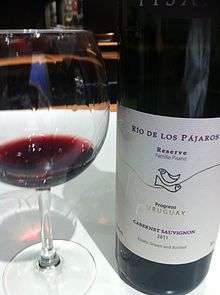
Cabernet Sauvignon is grown in nearly every South American country including Chile, Bolivia, Brazil, Peru and Uruguay. In Chile, the wines were historically limited by the excessively high yields that were commonplace throughout the country. As producers begun to concentrate on limiting yields, regional differences began to emerge that distinguished Chilean Cabernets. For vineyard plantings along flat river valleys, the climate of the region is the most important consideration; as plantings move to higher elevations and along hillsides, soil type is a greater concern. The wines of the Aconcagua region are noted for their ripe fruit but closed, tight structure that needs some time in the bottle to develop. In the Maipo Valley, Cabernet Sauvignon wines are characterized by their pervasive blackcurrant fruit and an earthy, dusty note. In warmer regions, such as the Colchagua Province and around Curicó, the grapes ripen more fully; they produce wines with rich fruit flavors that can be perceived as sweet due to the ripeness of the fruit. The acidity levels of these wines will be lower and the tannins will also be softer, making the wines more approachable at a younger age.[3]
Argentina
In Argentina, Cabernet Sauvignon lags behind Malbec as the country's main red grape but its numbers are growing. The varietal versions often have lighter fruit flavors and are meant to be consumed young. Premium examples are often blended with Malbec and produce full, tannic wines with leather and tobacco notes.[3] In recent years, there have been increased plantings of Cabernet Sauvignon in the Uco Valley of the Mendoza Province; the wines coming from vineyards planted at higher altitudes garner some international attention.[5]
Australia
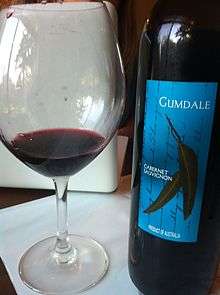
In the 1970s, the Coonawarra region first brought international attention to Australian Cabernet Sauvignons with intense fruit flavors and subtle minty notes. The Margaret River region soon followed with wines that were tightly structured with pronounced black fruit notes. In the 1980s, Australia followed California's contemporary trend in producing lighter, more "food friendly" wines with alcohol levels around 11-12% percent; by the early 1990s, the styles changed again to focus on balance and riper fruit flavors. Today Cabernet Sauvignon is the second most widely planted red wine grape in Australia, following Shiraz with which it is often blended. It can be found in several wine regions with many large producers using grapes from several states. Notable regional differences characterize Australian Cabernet Sauvignon: in addition to the wine styles of Coonawarra and Margaret River, the Barossa Valley produces big, full bodied wines while the nearby, cooler Clare Valley produces wines with more concentrated fruit, and wines of the Victorian wine region of the Yarra Valley are noted for their balance in acidity, tannins and fruit flavors.[3]
Other New World producers
Since the end of apartheid, the South African wine industry has been working to reestablish itself in the world's wine markets with many regions actively promoting their Cabernet Sauvignon. Today it is the most widely planted red wine grape in South Africa. It is produced in both varietal and blended styles; some producers favor a Bordeaux blend, while others follow the Australian example of blending with Syrah.[1] Early examples of South African Cabernet Sauvignon were produced by grapes planted in vineyard locations that were cooler than ideal, creating very herbaceous wines with the distinctive "green bell pepper" notes. In the mid-1990s, there was more emphasis on harvesting at fuller ripeness, and new clones were introduced that produced riper, sweeter fruit. As the vines age, and better vineyards locations are identified, regional styles are starting to emerge among South African Cabernet Sauvignons: the Stellenbosch region is noted for heavy, full bodied wines while Constantia's wines are characterized by their herbal and minty flavors.[3]
In New Zealand, climate has been a challenge in finding wine regions suitable for producing Cabernet Sauvignon. Most of the industry focus has centered on the North Island. The Hawkes Bay region was the first to make a significant effort in producing Cabernet Sauvignon but the cool climate of the region, coupled with the high yields and fertile alluvial soils, produced wines that were still marked with aggressive green and vegetal flavors. Added focus on canopy management, which gives the grapes more sunlight to ripen by removing excess foliage, and low vigor rootstock and pruning combine to achieve lower yields and have started to produce better results. The grape is sometimes blended with Merlot to help compensate for climate and terroir. Other regions in New Zealand have sprung up with a renewed focus on producing distinctive New Zealand Cabernet Sauvignon:[3] The Gimblett Road and Havelock North regions of Hawkes Bay, with their warm gravel soils, have started to achieve notice as well as Waiheke Island near Auckland.[5] Overall the grape lags far behind Pinot noir in New Zealand's red wine grape plantings.[1]
Popularity and criticism
In the past century, Cabernet Sauvignon has enjoyed a swell of popularity as one of the noble grapes in the world of wine. Built partially on its historical success in Bordeaux as well as New World wine regions like California and Australia, planting the grape is considered a solid choice in any wine region that is warm enough to cultivate it. Among consumers Cabernet has become a familiar wine which has aided in its accessibility and appeal even from obscure wine regions and producers. In the 1980s, the Bulgarian wine industry was largely driven and introduced to the international wine market by the success of its Cabernet Sauvignon wines. The widespread popularity of Bordeaux has contributed to criticism of the grape variety for its role as a "colonizer" grape, being planted in new and emerging wine regions at the expense of focus on the unique local grape varieties. Some regions, such as Portugal with its abundance of native grape varieties, have largely ignored Cabernet Sauvignon as it seeks to rejuvenate its wine industry beyond Port production.[3]
Wine styles
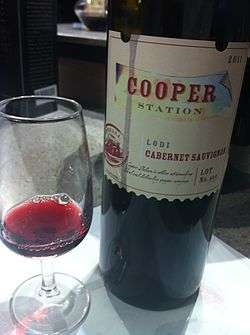
The style of Cabernet Sauvignon is strongly influenced by the ripeness of the grapes at harvest. When more on the unripe side, the grapes are high in pyrazines and will exhibit pronounced green bell peppers and vegetal flavors. When harvested overripe the wines can taste jammy and may have aromas of stewed blackcurrants. Some winemakers choose to harvest their grapes at different ripeness levels in order to incorporate these different elements and potentially add some layer of complexity to the wine. When Cabernet Sauvignon is young, the wines typically exhibit strong fruit flavors of black cherries and plum. The aroma of blackcurrants is one of the most distinctive and characteristic element of Cabernet Sauvignon that is present in virtually every style of the wine across the globe. Styles from various regions and producers may also have aromas of eucalyptus, mint and tobacco. As the wines age they can sometimes develop aromas associated with cedar, cigar boxes and pencil shavings. In general New World examples have more pronounced fruity notes while Old World wines can be more austere with heightened earthy notes.[3]
Ability to age
In the 19th and 20th centuries, a large part of Cabernet Sauvignon's reputation was built on its ability to age and develop in the bottle. In addition to softening some of their austere tannins, as Cabernet wines age new flavors and aromas can emerge and add to the wines' complexity. Historically this was a trait characterized by Bordeaux with some premium examples in favorable vintages having the potential to last for over a century, but producers across the globe have developed styles that could age and develop for several decades. Even with the ability to age, some Cabernet Sauvignon wines can still be approachable a few years after vintage. In Bordeaux, the tannins of the wines tend to soften after ten years and can typically last for at least another decade-sometimes longer depending on the producer and vintage. Some Spanish and Italian Cabernet Sauvignons will need similar time as Bordeaux to develop but most examples are typically made to be drunk earlier.[3]
While New World Cabernets are characterized as being drinkable earlier than Bordeaux, premium producers such as the Californian cult wines will produce wines that need time to age and could potentially develop for two to three decades. Overall, the majority of Californian Cabernets are meant to be approachable after only a couple of years in the bottle but can still have the potential to improve further over time. Similarly many premium Australian Cabernet will also need at least ten years to develop though many are approachable after two to five years. New Zealand wines are typically meant to be consumed young and will often maintain their green herbal flavors even with extended bottle aging. South American Cabernets have very pronounced fruit flavors when they are young and the best made examples will maintain some of those flavors as they age. South African wines tend to favor more Old World styles and typically require six to eight years' aging before they start to develop further flavors.[3]
Pairing with food
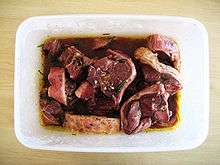
Cabernet Sauvignon is a very bold and assertive wine that has potential to overwhelm light and delicate dishes. The wine's high tannin content as well as the oak influences and high alcohol levels associated with many regional styles play important roles in influencing how well the wine matches with different foods. When Cabernet Sauvignon is young, all those elements are at their peak, but as the wine ages it mellows; possibilities for different food pairings open up. In most circumstances, matching the weight (alcohol level and body) of the wine to the heaviness of the food is an important consideration. Cabernet Sauvignons with high alcohol levels do not pair well with spicy foods due to hotness levels of the capsaicins present in spices like chili peppers being enhanced by the alcohol with the heat accentuating the bitterness of the tannins. Milder spices, such as black pepper, pair better due to their ability to minimize the perception of tannins—such as in the classic pairings of Cabernet Sauvignon with steak au poivre and pepper-crusted ahi tuna.[5]
Fats and proteins reduce the perception of tannins on the palate. When Cabernet Sauvignon is paired with steak or dishes with a heavy butter cream sauce, the tannins are neutralized, allowing the fruits of the wine to be more noticeable. In contrast, starches such as pastas and rice will have little effect on tannins. The bitterness of the tannins can also be counterbalanced by the use of bitter foods, such as radicchio and endive, or with cooking methods that involve charring like grilling. As the wine ages and the tannins lessen, more subtle and less bitter dishes will pair better with Cabernet Sauvignon. The oak influences of the wine can be matched with cooking methods that have similar influences on the food-such as grilling, smoking and plank roasting. Dishes that include oak-influenced flavors and aromas normally found in Cabernet Sauvignon—such as dill weed, brown sugar, nutmeg and vanilla—can also pair well.[5]

The different styles of Cabernet Sauvignon from different regions can also influence how well the wine matches up with certain foods. Old World wines, such as Bordeaux, have earthier influences and will pair better with mushrooms. Wines from cooler climates that have noticeable vegetal notes can be balanced with vegetables and greens. New World wines, with bolder fruit flavors that may even be perceived as sweet, will pair well with bolder dishes that have lots of different flavor influences. While Cabernet Sauvignon has the potential to pair well with bitter dark chocolate, it will not pair well with sweeter styles such as milk chocolate. The wine can typically pair well with a variety of cheeses, such as Cheddar, mozzarella and Brie, but full flavored or blue cheeses will typically compete too much with the flavors of Cabernet Sauvignon to be a complementary pairing.[5]
Health benefits
In late 2006, the Federation of American Societies for Experimental Biology published the result of studies conducted at the Icahn School of Medicine at Mount Sinai that showed the beneficial relationship of resveratrol, a compound found in all red wine, in reducing the risk factors associated with Alzheimer's disease. The study showed that resveratrol found in Cabernet Sauvignon can reduce levels of amyloid beta peptides, which attack brain cells and are part of the etiology of Alzheimer's.[21] Resveratrol has also been shown to promote the clearance of amyloid-beta peptides.[22] It has also been shown that non-alcoholic extracts of Cabernet Sauvignon protect hypertensive rats during ischaemia and reperfusion.[23]
See also
References
- Robinson, J., ed. (2006). The Oxford Companion to Wine (Third ed.). Oxford University Press. pp. 119–121. ISBN 0-19-860990-6.
- "Distribution of the world's grapevine varieties" (PDF). oiv.int. International Organisation of Vine and Wine. 28 February 2018. Archived from the original (PDF) on 2018-03-01. Retrieved 1 March 2018.
- Clarke, Oz (2001). Encyclopedia of Grapes. Harcourt Books. pp. 47–56. ISBN 0-15-100714-4.
- Wine & Spirits Education Trust "Wine and Spirits: Understanding Wine Quality" pgs 6-9, Second Revised Edition (2012), London, ISBN 9781905819157
- Goldstein, E. (2006). Perfect Pairings. University of California Press. pp. 134–139. ISBN 978-0-520-24377-4.
- Carpenter, Kasey (2016-11-18). "Scientists Unravel Cabernet Sauvignon's Genome". Wine Spectator. Retrieved 2016-11-30.
- Alley, L. (September 30, 2007). "New French Wine Grape Arrives in US Market". The Wine Spectator. p. 17.
- J. Robinson, J. Harding and J. Vouillamoz Wine Grapes – A complete guide to 1,368 vine varieties, including their origins and flavours pgs 148-149, 285-286 Allen Lane 2012 ISBN 978-1-846-14446-2
- Cleggett wines: Archived 2007-08-29 at the Wayback Machine history and pictures of the gris and white mutants; Transcript of ABC show about bronze and white mutants
- Walker, A. R.; Lee, E.; Robinson, S. P. (2006). "Two new grape cultivars, bud sports of Cabernet Sauvignon bearing pale-coloured berries, are the result of deletion of two regulatory genes of the berry color locus". Plant Mol Biol. 62 (4–5): 623–635. doi:10.1007/s11103-006-9043-9.
- J. Robinson, J. Harding and J. Vouillamoz Wine Grapes — A complete guide to 1,368 vine varieties, including their origins and flavours pgs 469-471, 594-595 Allen Lane 2012 ISBN 978-1-846-14446-2
- "Cienna Factsheet" (PDF). CSIRO. Archived from the original (PDF) on 27 September 2007. Retrieved 22 July 2019.
- Vitis International Variety Catalogue (VIVC) Souvignier gris Archived 2014-02-03 at the Wayback Machine Accessed: January 20th, 2014
- Rutherford Dust Society "About us" Accessed: February 22nd, 2008
- Stevenson, T. (2005). The Sotheby's Wine Encyclopedia. Dorling Kindersley. pp. 578–581. ISBN 0-7566-1324-8.
- D. Mouer "Meritage: What's in a Name Archived 2013-05-25 at the Wayback Machine" Wine Maker Magazine, August 2004
- For contrast, Sémillon has a 1:25 pip to pulp ratio.
- Ewing-Mulligan, M.; McCarthy, E. (2001). Italian Wines for Dummies. Hungry Minds. pp. 155 & 167–169. ISBN 0-7645-5355-0.
- Driscoll, Killian. "Guide to the wine grape varieties in Spain". artobatours.com. Retrieved 3 February 2020.
- Driscoll, Killian. "Guide to the wine regions of Spain, part 1". artobatours.com. Retrieved 3 February 2020.
- J. Gaffney "Drinking Cabernet May Cut Risk of Alzheimer's, Study Finds", Wine Spectator Magazine, December 31, 2006, pg 17
- Marambaud P, Zhao H, Davies P (November 2005). "Resveratrol promotes clearance of Alzheimer's disease amyloid-beta peptides". J. Biol. Chem. 280 (45): 37377–82. doi:10.1074/jbc.M508246200. PMID 16162502.
- Fantinelli, J. C.; Mosca, S. M. (2007). "Cardioprotective effects of a non-alcoholic extract of red wine during ischaemia and reperfusion in spontaneously hypertensive rats". Clin. Exp. Pharmacol. Physiol. 34 (3): 166–169. doi:10.1111/j.1440-1681.2007.04567.x. PMID 17250634.
External links
- Cabernet Sauvignon Grape - Cabernet Sauvignon Grape Information Page on appellationamerica.com
- Cabernet Sauvignon - Cabernet Sauvignon on DryRedWines.com